5 Animals used in Ancient Warfare Posted by Brittany Britanniae on Apr 29, 2015 in Roman culture
DISCLAIMER: Since this is a Latin blog, I have chosen only to focus on animals used in Roman battles or wars. Thus, I understand that some of these animals have older warfare uses, but the focus here is on Roman period uses.
1. WAR ELEPHANT
Animal: North African Forest Elephant, Carthaginian Elephant, Atlas Elephants, “Hannibal’s Elephants”
Alive or Extinct: Extinct from over-exploitation
Year: 218 B.C.E
Battle or War: Second Punic War at the Battle of Trebia.
How was it used: A war elephant was an elephant trained and guided by humans for combat. Their main use was to charge the enemy, breaking their ranks and instilling terror. Elephantry are military units with elephant-mounted troops.
Sources: Polybius & Livy (here)
Fun Facts: The favorite, and perhaps last surviving elephant of Hannibal’s 218 B.C. crossing of the Alps was an impressive animal named Surus (“the Syrian” or “One-Tusker”), and may have been of Syrian stock, though the evidence remains ambiguous.
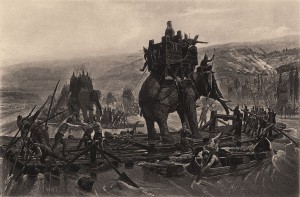
Before crossing the Alps, Hannibal had to cross the Rhone River. Credit: War elephants depicted in Hannibal Barca crossing the Rhône, by Henri Motte, 1878. Courtesy of WikiCommons.
Advantage or Disadvantage: The elephants had such a difficult time crossing the Alps due to the terrain, cold winter weather, and the fact that roads had to be built for them to cross. This wasted a lot of time and resulted in the surviving elephants being quite famished. However, the surviving elephants were successfully used in the battle of Trebia, where they panicked the Roman cavalry and Gallic allies.
Last Used: Although, the elephant that is being discussed is the North African Forest Elephant, I believe it is important to know in general how elephants were used within war or battle.
In south-east Asia the use of elephants on the battlefield continued up until the end of the 19th century. One of the major difficulties in the region was terrain, and elephants could cross difficult terrain in many cases more easily than horse cavalry.
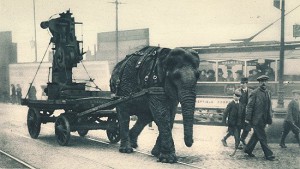
During World War I, elephants pulled heavy equipment. This one worked in a munitions yard in Sheffield. Courtesy of WikiCommons.
Into the 20th century, non-battle-trained elephants were used for other military purposes as late as World War II,particularly because the animals could perform tasks in regions that were problematic for modern vehicles.
2. War Pigs
Animal: The pig or boar
Alive or Extinct: There is no certainty as to the species of pig or boar, so in general pigs/boars are still in existence.
Year: 275 B.C.E
Battle or War: Pyrrhic War
How was it used: War pigs are pigs reported to have been used in ancient warfare, mostly as a countermeasure against war elephants. Ancient historians confirm that elephants were frightened by squealing pigs (and rams with horns), and reported that the Romans exploited squealing pigs (and rams) to repel the war elephants at Pyrrhus.
Sources: Pliny the Elder (“Natural History” 8.9.27), Aelian, (“On Animals” 1.38), Lucretius( De Rerum Natura 5.1298-134)
Fun Facts: Historical accounts of incendiary pigs or flaming pigs were recorded by the military writer Polyaenus and by Aelian. (Note: The following video shows Rome Total War custom battle between War Elephants and War Pigs. While, it is not historically accurate. It is a bit a fun.)
Advantage or Disadvantage: The elephants bolted in terror from the flaming and/or squealing pigs, often killing great numbers of their own soldiers by trampling them to death. However, there is some uncertainty as the war elephants could flee in either direction stomping and killing soldiers.
Last Used: There is no evidence that the war pig survived beyond antiquity. This, of course, is a logically deduction as its primary purpose was to defeat the war elephant. However, another reason why it may have not succeeded as a new and productive tactic is due to its uncertainty.
3. War Dogs
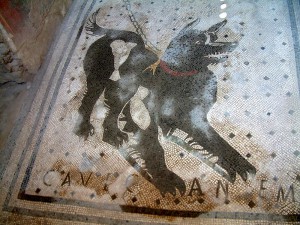
Cave canem mosaics (‘Beware of the dog’) were a popular motif for the thresholds of Roman villas. Courtesy of WikiCommons.
Animal: The Dog
Alive or Extinct: Alive
Year: 231 B.C.E
Battle or War: A war against the Sardinians.
How was it used: Romans, dogs served most often as sentries or patrols, though they were sometimes taken into battle. Written accounts by the Roman writers and historians Plutarch and Pliny exist, and Strabo, a Greek historian, described the dogs being “protected with coats of mail.”
Sources: Livy (Book 22)
Fun Facts: War dogs were used by the Egyptians, Greeks, Persians, Sarmatians, Baganda, Alans, Slavs, Britons, and the Romans.
Advantage or Disadvantage: The Roman consul Marcus Pomponius Matho, leading the Roman legions through the inland of Sardinia, where the inhabitants led guerrilla warfare against the invaders, used “dogs from Italy” to hunt out the natives who tried to hide in the caves
Last Used: Contemporary dogs in military roles are also often referred to as police dogs, or in the United States as a Military Working Dog (MWD), or K-9. Their roles are nearly as varied as their ancient cousins, though they tend to be more rarely used in front-line formations. As of 2011, 600 U.S. Military dogs were actively participating in the conflicts in Iraq and Afghanistan
4. War Horses
Animal: Horses
Alive or Extinct: While it is unclear which species of horse was used by the Ancient Romans. It is clear that horses are in general not extinct.
Year: 9 August 48 BC
Battle or War: Battle of Pharsalus (For the logistics of the battle, the video below goes into a greater detail than I could.)
How was it used: In antiquity, horses have been used to simply riding, transportation, cavalry, chariots, and as beast of burden. Cavalry was not used extensively by the Romans during the Roman Republic period, but by the time of theRoman Empire, they made use of heavy cavalry.
Sources: Plutarch Pompey 65.5
Fun Facts: The saddle with a solid framework, or “tree”, provided a bearing surface to protect the horse from the weight of the rider. The Romans are credited with the invention of the solid-treed saddle.
Advantage or Disadvantage:When Pompey determined that his cavalry had been routed by an inferior force (Caesar: 22,000 Infantry & 1,000 Cavalry; Pompey: 45,000 Infantry & 7,000 Cavalry), he fled and retreated. Thus, it proves the importance of cavalry forces but not necessarily the size.
Last Used: Today, many of the historical military uses of the horse have evolved into peacetime applications, including exhibitions, historical reenactments, work of peace officers, and competitive events. Formal combat units of mounted cavalry are mostly a thing of the past, with horseback units within the modern military used for reconnaissance, ceremonial, or crowd control purposes.
5. Pigeons
Animal: Pigeon
Alive or Extinct: Alive and Well.
Year: 58–50 BC
Battle or War: Gallic Wars
How was it used: Pigeons have long played an important role in war. Due to their homing ability, speed, and altitude, they were often used as military messengers. The Romans used pigeon messengers for over 2000 years ago. In Ancient Rome, within many texts, there are references to pigeons being used to send messages by Julius Caesar.
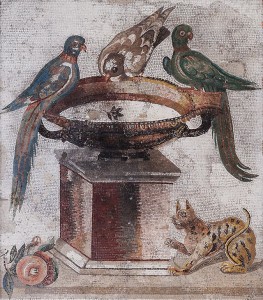
Roman Mosaic from House of Faun. Detail of middle bird possibly being a pigeon. Courtesy of WikiCommons, Marie-Lan Nguyen, Jastrow.
Sources: Frontius (Stratagems Second book, XIII, 8)
Fun Facts: Pigeons have been used to great effect in military situations, with 32 birds awarded the Dickin Medal.
Advantage or Disadvantage: This one is a bit tricky, because while it would be advantageous to have information reach allies quickly and secretly. Pigeons are noticeable and could be intercepted.
Last Used: During World War II, the UK used about 250,000 homing pigeons, They ceased being used as of 1957.
HONORABLE MENTION:
THE TORTOISE
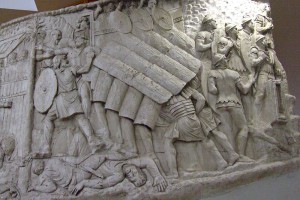
Tortoise or Testudo Formation. Rendered on Trajan’s Column. Courtesy of WikiCommons & CristianChirita.
While the tortoise was not used as the animal, it inspired a famous formation known as the testudo or tortoise formation.
A demonstration of a reenactment event can be seen here:

Build vocabulary, practice pronunciation, and more with Transparent Language Online. Available anytime, anywhere, on any device.
About the Author: Brittany Britanniae
Hello There! Please feel free to ask me anything about Latin Grammar, Syntax, or the Ancient World.



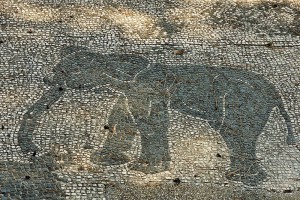
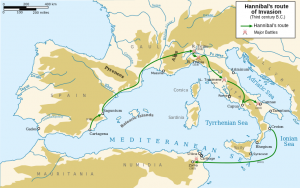
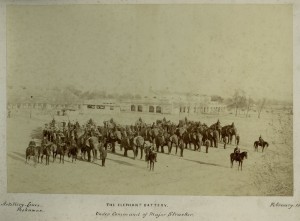
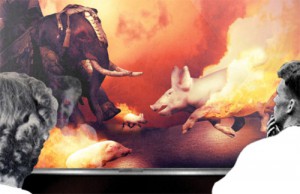
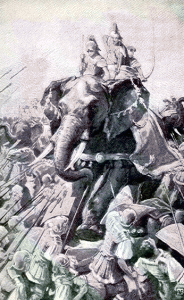
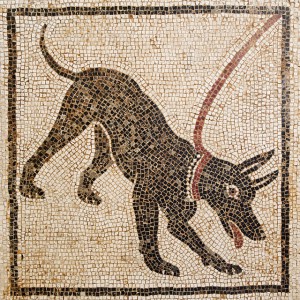
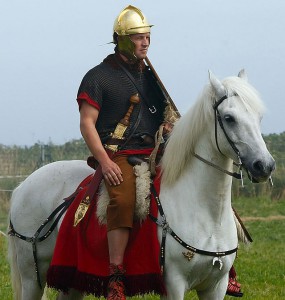
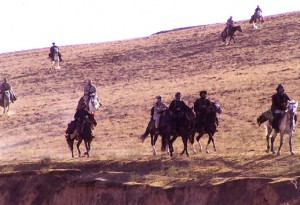
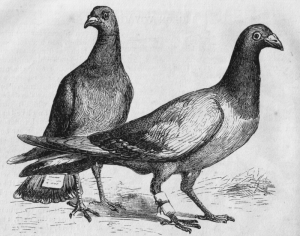

Comments:
Pritom:
I’m surprised. There is name of war elephant but no mention of India. When it was the 1st & most efficient nation to ever use it in the warfare. They even deployed this unit in the largest number